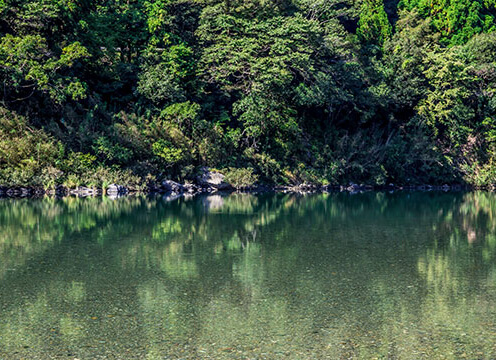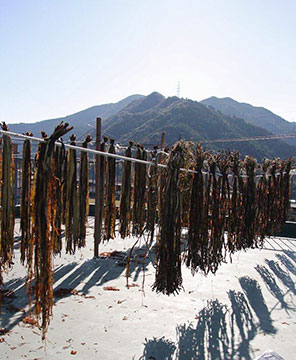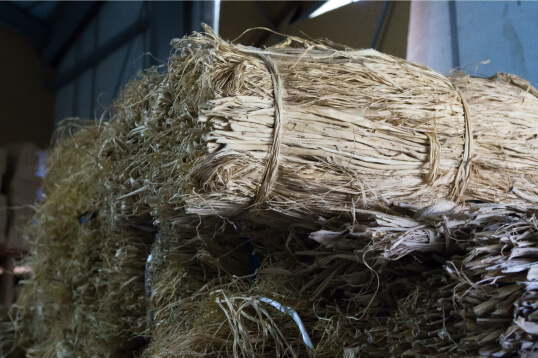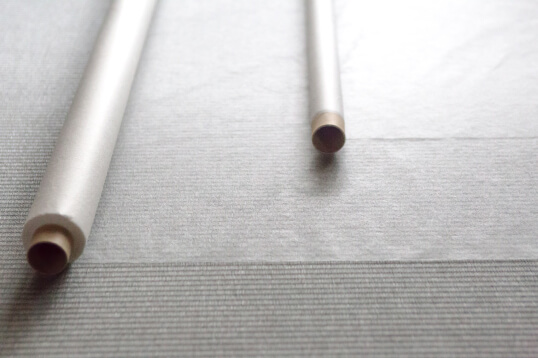Devotion towards producing genuine washi paper

元紙業試験場 濵田康 Former Paper Making Testing Facility HAMADA Kou
高知は古くから紙の産地として良く知られた土地です。四国の山地は急傾斜地が多く、普通の農業は出来ないところもあり、その様な土地では昔から紙の原料となる楮、三椏の栽培が行われていました。また、紙の原料の楮をパルプ化する石灰の元となる石灰石は、県内のあちこちで見られ、それを焼成、利用する技術は古くから土佐漆喰で有名でした。その時にできる酸化カルシウムCaOを俗に石灰と呼んで、水に入れると強いアルカリ性を示すことから、楮の煮熟に使用してきました。
紙を作る時には沢山の水を使います。四国山脈の南側には多くの河川があり清澄な水が豊富です。この様な背景があり、高知は紙の一大産地として栄えて来たのです。
Kochi is widely known for its paper production throughout the ages. Kozo and mitsumata, which are raw materials for paper, were planted in areas where regular farming was difficult due to the steep slopes in mountainous areas of Shikoku. In addition, limestone (the basis for lime) which was used for pulping kozo, was found throughout Kochi. The techniques to fire limestone were widely known when producing Tosa Shikkui (Tosa plaster). While firing, Calcium Oxide (CaO) is produced, and this is known as lime. Once the lime is placed in water, it turns highly alkaline. This water was used to boil down kozo.
On the southern side of Shikoku mountain range, there are many rivers that have blessed the area resourced of water. When producing paper, water is used heavily. This is why Kochi prospered as a paper production area.


特にいの町の仁淀川沿いの神谷村は、典具帖紙の生産が県下で一番多く生産されていました。この様にいの町を中心として盛んに生産された典具帖紙は、かつては印刷の必需品として世界に輸出されてきました。しかし印刷技術の発達はめざましく、それまで印刷には欠かせないとされきた、典具帖紙は新しく台頭として来た印刷技術に次第に席を譲り、今日では全く使用されていません。
典具帖紙は印刷に使われるので、紙に不揃いがあれば印刷にその儘現れるため、非常に均一性を求められる紙でした。一方楮の繊維は紙に使用する植物繊維としては長く10~12mmくらいあるので扱い方が面倒で、扱い方が悪いとすぐに紙に「むら」を生じる原因となりました。このため紙漉き職人は大変熟練した難しい紙すき作業を強いられます。いの町の仁淀川筋に沢山いた紙を漉く人たちは、全てこの高度な技術を身につけておりました。
Tengu-Joshi was exported globally as a necessary goods for typewriter printing, was produced in Konotani village located along Niyodo river in Ino town. Although Tengu-Joshi was indispensable for printing, printing technology development was remarkable. It gradually gave up its seat to new technologies and currently Tengu-Joshi is no longer used for any purpose.
Tengu-Joshi required high-uniformity since it was used for printing. If there were any irregularities in the paper, it appeared in the print. Tengu-Joshi used kozo which was troublesome to handle since its fibers were about 10 to 12mm long. It caused “unevenness“ to the paper if the craftsman did not handle them carefully. For this reason, craftsman needed high-quality skills. All craftsman who worked near Niyodo river acquired this advanced technique.

しかし先に述べたように新しい印刷技術の台頭により、今日ではその紙が使われなくなったので、この技術を持った多くの職人も廃業のやむなきに至った訳です。
一度廃れた技術を復活させることは、先ず不可能に近いと言っても過言では有りません。しかも技術が廃れるばかりではなく、紙の需要がなくなったので、その原料である楮の生産も激減し、今では国内産の楮の生産はごく僅かになり、殆どが外国産の楮に依存している現状です。
However as mentioned earlier, Tengu-Joshi were no longer in use due to new printing technology, and many highly skilled craftsmen went out of business.
It is no exaggeration to say that reviving a technique that has once diminished are nearly impossible. Moreover, it is not only the techniques, but also the production of kozo that has decreased drastically due to the end of demand. Most kozo are now imported and very few are grown in Japan.


この様な現状の中で本来の楮処理技術をかたくなに守り、しかも国産楮のみ使用して日本本来の楮の紙を「手漉きと機械抄きで」抄き続けている工場は、鹿敷製紙の他に例を見ません。外国から輸入した楮を使い、如何なる方法で紙を漉いても、それは既に日本本来の紙ではありません。
日本本来の原料で造られた紙を使えばこそ、日本古来の絵画、書など日本で培われた芸術を乗せて長くそれを保存できると考えます。
外国産の楮を使えば、時間の経過と共に生じてくるトラブルもあります。一方日本本来の原料を使用して造られた紙を使用した芸術作品は、何百年の時を経ても狂いがありません。多くの作品が残され今日私たちの目を楽しませてくれています。
Despite such situation, Kashiki Paper Co., Ltd is the only company that uses Japan grown kozo and protects kozo processing technology. They continue to make “hand-made and machine-made“ kozo paper. Any paper using imported kozo, despite its paper making process, is not a genuine Japanese paper.
I believe that paper made from genuine raw materials in Japan, can only preserve art works, such as ancient Japanese paintings and books, for a long period of time.
Paper made from genuine materials preserve art works without harming them for hundreds of years. In fact, many art works are preserved with Japanese paper and they entertain us still today. If we use imported kozo, troubles may occur over time.

純国産の楮原料を使い、典具帖紙の楮繊維の扱いの流れを汲み、造られる紙であるから古文書、国宝の修復にも使われ、これから作品を残そうとされる方々にも安心してお使い頂けます。
鹿敷製紙は楮のみならず、ガンピ、三椏など全ての紙の原料に於いても我が国本来の紙の技術を生かし、使う人の意にかなう紙を作るように日夜努力して行くいくと期待しています。
I recommend Kashiki’s paper for those planning to preserve art works for many years. Kashiki’s paper uses Japan grown kozo, and the fiber is handled with the same techniques to produce Tengu-Joshi. Their paper is widely used to restore ancient documents and national treasures.
I hope that Kashiki Paper Co., Ltd will continue its efforts to meet the expectation of their users and preserve Japans genuine paper producing technology by using kozo, gampi and mitsumata, and other raw materials grown in Japan.


